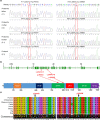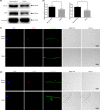EIF4G1 is a novel candidate gene associated with severe asthenozoospermia
- PMID: 31268247
- PMCID: PMC6687618
- DOI: 10.1002/mgg3.807
EIF4G1 is a novel candidate gene associated with severe asthenozoospermia
Abstract
Background: Asthenozoospermia (AZS), also known as asthenospermia, is characterized by reduced motility of ejaculated spermatozoa and is detected in more than 40% of infertile patients. Because the proportion of progressive spermatozoa in severe AZS is <1%, severe AZS is an urgent challenge in reproductive medicine. Several genes have been reported to be relevant to severe asthenospermia. However, these gene mutations are found only in sporadic cases and can explain only a small fraction of severe AZS, so additional genetic pathogenies need to be explored.
Methods and results: By screening the variant genes in a patient with severe AZS using whole exome sequencing, we identified biallelic mutations c.2521C>T: p.(Pro841Ser) (NC_000003.11: g.184043412C>T) in exon13 and c.2957C>G: p.(Ala986Gly) (NC_000003.11: g.184045117C>G) in exon17 in the eukaryotic translation initiation factor 4 gamma 1 gene (EIF4G1, RefSeq: NM_004953.4, OMIM: 600495) of the patient. Both of the mutation sites are rare and potentially deleterious. Transmission electron microscopy analysis showed a disrupted axonemal structure with mitochondrial sheath defects. The EIF4G1 protein level was extremely low, and the mitochondrial marker cytochrome c oxidase subunit 4I1 (COXIV, OMIM: 123864) and mitochondrially encoded ATP synthase 6 (ATP6, OMIM: 516060) protein levels were also decreased in the patient's spermatozoa as revealed by WB and IF analysis. This infertility associated with this condition was overcome by intracytoplasmic sperm injections, as his wife became pregnant successfully.
Conclusion: Our experimental findings indicate that the EIF4G1 gene is a novel candidate gene that may be relevant to severe AZS.
Keywords: EIF4G1; biallelic mutation; severe asthenozoospermia; whole exome sequencing.
© 2019 The Authors. Molecular Genetics & Genomic Medicine published by Wiley Periodicals, Inc.
Conflict of interest statement
None declared.
Figures




Similar articles
-
Novel variants in DNAH9 lead to nonsyndromic severe asthenozoospermia.Reprod Biol Endocrinol. 2021 Feb 20;19(1):27. doi: 10.1186/s12958-021-00709-0. Reprod Biol Endocrinol. 2021. PMID: 33610189 Free PMC article.
-
A familial study of twins with severe asthenozoospermia identified a homozygous SPAG17 mutation by whole-exome sequencing.Clin Genet. 2018 Feb;93(2):345-349. doi: 10.1111/cge.13059. Epub 2017 Sep 4. Clin Genet. 2018. PMID: 28548327
-
Homozygous mutation in SLO3 leads to severe asthenoteratozoospermia due to acrosome hypoplasia and mitochondrial sheath malformations.Reprod Biol Endocrinol. 2022 Jan 3;20(1):5. doi: 10.1186/s12958-021-00880-4. Reprod Biol Endocrinol. 2022. PMID: 34980136 Free PMC article.
-
Genetic underpinnings of asthenozoospermia.Best Pract Res Clin Endocrinol Metab. 2020 Dec;34(6):101472. doi: 10.1016/j.beem.2020.101472. Epub 2020 Nov 6. Best Pract Res Clin Endocrinol Metab. 2020. PMID: 33191078 Review.
-
Molecular genetics of infertility: loss-of-function mutations in humans and corresponding knockout/mutated mice.Hum Reprod Update. 2021 Jan 4;27(1):154-189. doi: 10.1093/humupd/dmaa034. Hum Reprod Update. 2021. PMID: 33118031 Review.
Cited by
-
Novel variants in DNAH9 lead to nonsyndromic severe asthenozoospermia.Reprod Biol Endocrinol. 2021 Feb 20;19(1):27. doi: 10.1186/s12958-021-00709-0. Reprod Biol Endocrinol. 2021. PMID: 33610189 Free PMC article.
-
The Loss-Function of KNL1 Causes Oligospermia and Asthenospermia in Mice by Affecting the Assembly and Separation of the Spindle through Flow Cytometry and Immunofluorescence.Sensors (Basel). 2023 Feb 25;23(5):2571. doi: 10.3390/s23052571. Sensors (Basel). 2023. PMID: 36904774 Free PMC article.
-
ICSI outcomes for infertile men with severe or complete asthenozoospermia.Basic Clin Androl. 2022 Apr 5;32(1):6. doi: 10.1186/s12610-022-00155-x. Basic Clin Androl. 2022. PMID: 35382740 Free PMC article.
-
Novel FSIP2 Variants Induce Super-Length Mitochondrial Sheath and Asthenoteratozoospermia in Humans.Int J Biol Sci. 2023 Jan 1;19(2):393-411. doi: 10.7150/ijbs.76051. eCollection 2023. Int J Biol Sci. 2023. PMID: 36632462 Free PMC article.
-
Towards Post-Meiotic Sperm Production: Genetic Insight into Human Infertility from Mouse Models.Int J Biol Sci. 2021 Jun 16;17(10):2487-2503. doi: 10.7150/ijbs.60384. eCollection 2021. Int J Biol Sci. 2021. PMID: 34326689 Free PMC article. Review.
References
-
- Amer, M. , Metawae, B. , Hosny, H. , & Raef, A. (2013). Beneficial effect of adding pentoxifylline to processed semen samples on ICSI outcome in infertile males with mild and moderate asthenozoospermia: A randomized controlled prospective crossover study. Iranian Journal of Reproductive Medicine, 11(11), 939–944. - PMC - PubMed
Publication types
MeSH terms
Substances
LinkOut - more resources
Full Text Sources
Miscellaneous

